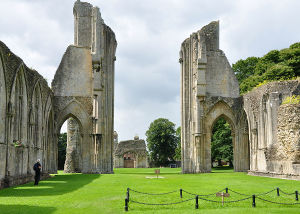Glastonbury: Difference between revisions
(Additional content) |
m (Cross reference to Community of Glastonbury) |
||
| Line 1: | Line 1: | ||
[[File:Glastonbury Abbey ruins 6.jpg|thumb|alt=caption|Ruins of Glastonbury Abbey. The former location of the high alter is marked in the foreground; beyond it is the site claimed to have been the grave of Arthur and Guinevere.]] | [[File:Glastonbury Abbey ruins 6.jpg|thumb|alt=caption|Ruins of Glastonbury Abbey. The former location of the high alter is marked in the foreground; beyond it is the site claimed to have been the grave of Arthur and Guinevere.]] | ||
''This article is about Glastonbury in England. For the community near the [[Royal Teton Ranch]], see'' [[Community of Glastonbury]]. | |||
Glastonbury is an ancient town in Somerset, southwest England, which, according to legend, is the place where [[Joseph of Arimathea]] and [[Mother Mary]] brought the [[Holy Grail]] and founded the first Christian church in England. This chalice then became the focus for the expansion of Christianity throughout the known world. | Glastonbury is an ancient town in Somerset, southwest England, which, according to legend, is the place where [[Joseph of Arimathea]] and [[Mother Mary]] brought the [[Holy Grail]] and founded the first Christian church in England. This chalice then became the focus for the expansion of Christianity throughout the known world. | ||
| Line 32: | Line 35: | ||
''Heart'' magazine, winter 1985. | ''Heart'' magazine, winter 1985. | ||
** | |||
Revision as of 03:48, 17 September 2016

This article is about Glastonbury in England. For the community near the Royal Teton Ranch, see Community of Glastonbury.
Glastonbury is an ancient town in Somerset, southwest England, which, according to legend, is the place where Joseph of Arimathea and Mother Mary brought the Holy Grail and founded the first Christian church in England. This chalice then became the focus for the expansion of Christianity throughout the known world.
A monastic community formed around the ancient church at Glastonbury, known as Glastonbury Abbey. Written records of Welsh historical tradition state that in the fifth century a choir of 2,400 members kept a perpetual vigil at Glastonbury Abbey with 100 members present each hour. Glastonbury is also identified as the Isle of Avalon of Arthurian legend.
In the Middle Ages Glastonbury Abbey was a center of learning and a shrine to which many made pilgrimages. The site of Glastonbury is thought to have been a center of Druid worship as well. Glastonbury tradition says that the boy Jesus accompanied Joseph of Arimathea on one of his business trips to England and lived there for several years, studying and preparing for his mission.
Glastonbury and King Arthur
Some historical evidence of King Arthur’s life comes from Glastonbury Abbey. Some of the priests who served there during the sixth century preserved a record of their receipt of the disinterred bodies of both King Arthur and his queen, Guinevere. The bodies of the royal couple were buried beneath the high altar in the church.
According to an account by Giraldus Cambrensis, who was present when the grave was opened at the command of Henry II about the year 1190, the grave contained the bones and sword of King Arthur. It also contained a leaden cross which contained the following inscription: Here lies buried the famous King Arthur, in the island of Avalon.
Glastonbury is only twelve miles from the site archaeologists favor as Arthur’s castle—Cadbury.
See also
Sources
Pearls of Wisdom, vol. 32, no. 12.
Pearls of Wisdom, vol. 25, no. 58.
Lecture by Elizabeth Clare Prophet, April 20, 1973.
Lecture by Elizabeth Clare Prophet, May 22, 1983.
Heart magazine, winter 1985.
